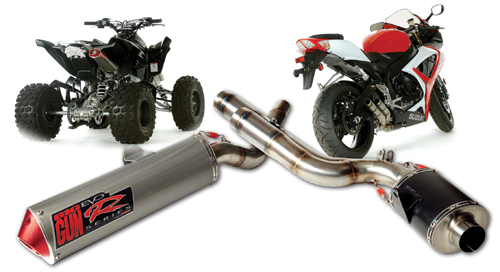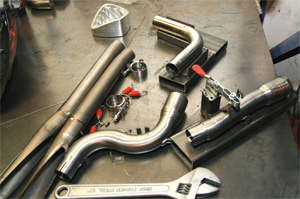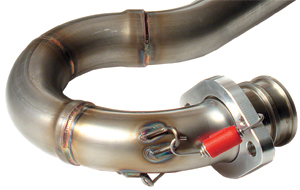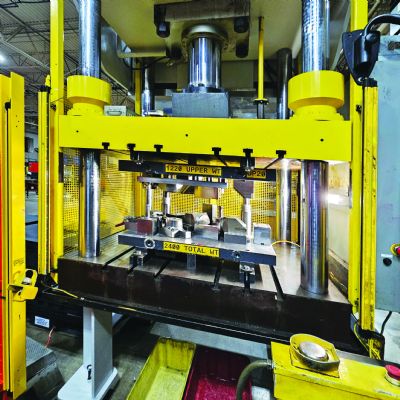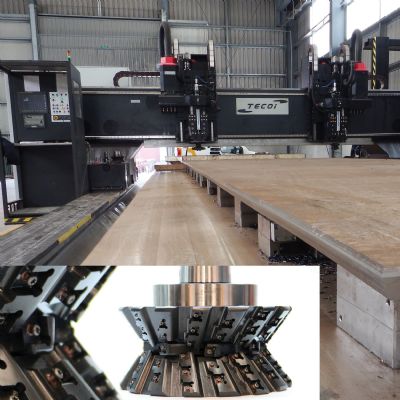Uniform Welding Pipe After Pipe
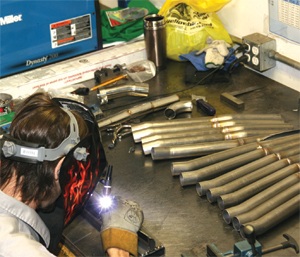 |
| Each fabricated pipe must be identically placed in the fixture in order to perform in exactly the same manner. The high-speed pulsing feature of Big Gun’s new welding machine constricts and focuses the arc, allowing operators greater control over arc stability and heat input, allowing parts to stay cool and avoid warping. |
|
The challenge of welding thin-gauge stainless steel involves achieving adequate penetration without overheating. Unlike other alloys, stainless steel does not adequately dissipate heat when welded, instead holding heat in the area of concentrated welding arc. Excess heat causes major problems, including warping, embrittlement and rust. Warping usually leads to costly part scrapping, and temperatures above 950 F cause stainless steel to become brittle, causing the alloy’s mechanical properties to fall short of required specifications. Excess heat also boils off stainless’ alloying elements and concentrates carbon, which remains trapped in the heat-affected zone as the steel cools. Given time, the area overloaded with carbon will rust, negating stainless steel’s best-known property.
Where excess heat, loss of mechanical properties and warping are issues, pulsed welding can provide the solution. With pulsed gas-tungsten-arc welding (GTAW), the arc pulses between a high peak and low background current. The peak current provides good penetration while the background current allows the weld puddle to cool slightly, preventing warping, embrittlement and carbide precipitation.
Higher pulsing—generally above 100 pulses/sec.—increases puddle agitation, which in turn optimizes grain molecular structure within the weld. High-speed pulsing also constricts and focuses the arc. This increases arc stability, penetration and travel speeds, and produces a small heat-affected zone.
High-speed pulsed GTAW requires using an inverter power supply. Conventional GTAW limits pulsing to a relatively narrow range of 0.25 to 10 pulses/sec., where inverter technology enables pulsing to 5000 pulses/sec.
Pulsed GTAW requires setting four variables: peak amperage, background amperage, peak time and pulse rate.
Peak amperage, peak time: Determine good values for setting peak amperage in the same manner as setting maximum amperage values for regular DC GTAW: 1 A for every 0.001 in. of thickness.
Peak time is the percentage of time during one pulsing cycle that the power source spends at the peak amperage (main amperage). With peak time of 80 percent and a rate of 1 pulse/sec., the inverter will spend 0.8 sec. at peak amperage and 0.2 sec. at background amperage. Increasing peak-time percentage adds more heat to the part, while decreasing reduces heat. As a rule of thumb, begin experimenting at 50 to 60 percent peak time.
Background amperage: The background amperage is a percentage of the main amperage set on the machine. Thus, a machine set for an output of 150 A and background amperage of 30 percent produces a background amperage output of 45 A. Lowering the background-amperage percentage reduces the average heat input, while increasing it raises overall amperage.
Notice how background-current adjustments affect weld-puddle fluidity. Use enough background current to shrink the puddle to about half of its normal size while still keeping the puddle fluid. When welding stainless and carbon steels, start by setting the background amperage at 20 to 30 percent of peak amperage.
Pulse rate: The pulse rate is how many times the machine will complete one pulsing cycle in a time span of 1 sec. Increasing the pulses/sec. produces a smooth ripple effect in the weld bead, narrows the weld bead and adds a cooling effect. Reducing the pulses/sec. widens the weld bead. Slower pulsing also helps agitate the puddle and releases any porosity or gas trapped in the weld.
Some beginning GTA welders use a slow pulsing rate—0.5-1 pulses/sec.—to help them develop a rhythm for adding filler metal. For welding carbon or stainless steel, use a rate of 100 to 500 pulses/sec., starting at 100 and working upward. Working at rates surpassing 500 pulses/sec. generally requires automated welding.
|
In terms of welding alone, the Dynasty helps Big Gun achieve uniformity because, among other things, operators have more heat-input control, according to Frank Sison, head of manufacturing at Big Gun.
“The crucial part of welding is not getting material hot to the point where it changes shape and doesn’t fit in the fixture,” says Sison. “With the Dynasty, I get a finer bead so the part stays cooler and doesn’t warp.”
Greater control is just one benefit of this advanced inverter-based power source, as the Dynasty has a state-of-the-art operator interface that offers a built-in pulser and more control of output parameters than a traditional GTA machine, according to Miller Electric officials. Prior to using the Dynasty 200 DX, Sison hadn’t worked with a pulsed welder, but he now appreciates pulsing for reducing heat input and adding arc stability. “I used to perform pulsed welding myself by hand,” says Sison. “The pulser is an ideal feature that, now, I don’t think I can work without.”
The ability to fine-tune output parameters saves Big Gun significant time.
“You get exactly the right-sized bead as you weld it,” says Sison. “And you don’t need to go over it and make it look pretty, because it’s pretty the first time.”
“Our welds look like they were performed by a robot, but are better because they are so flawless,” says Young, agreeing with Sison on bead appearance. “The fabrication is so clean, and everything has been deburred so well that it’s smooth, which is important because burrs can kill the power.”
Smooth Starts, Other Advantages to New Welder
Sison also notes the smooth starts associated with the GTA welding machine that assist in manufacturing gains at Big Gun.
“I can set the power supply on a lower amperage and actually work with it,” he says. “With our older machine, we could only go so low and the arc wouldn’t start. And when it did, it would blow a hole. You can actually finesse your start, and that’s what I really like about this machine.”
The Dynasty’s advanced inverter technology with Auto-Line power-management technology allows Big Gun to hookup to 120 to 460 V, single- or three-phase power with no manual linking, and reduces power draw.
“Our other machine sucked so much power out of this place,” says Young. “It was als popping breakers. Now we can run three machines at one time without any problem.”
At a rated output of 150 A, the Dynasty draws only 15.8 A of primary power. Compared to a conventional 250-A GTA welder, the Dynasty uses primary power four to five times more efficiently, according to Miller Electric officials. With such minimal amperage draw, Big Gun can plug in five of the welders for each conventional power supply. MF
Information for this article supplied by Miller Electric Manufacturing Co., Appleton, WI. Tel. 920/734-9821; www.millerwelds.com.
See also: Miller Electric Mfg. Co.
Technologies: Welding and Joining







